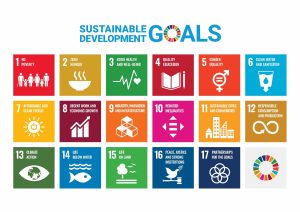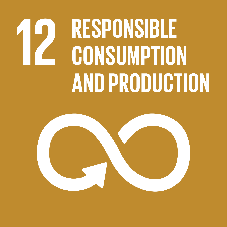UN Sustainable Development Goals – A Primer
Posted: September 19th, 2023
Authors: Aria C.
In 2015, the United Nations (UN) proposed 17 goals based on various topics, with the aim of improving quality of life and the environment around the world. These 17 “Sustainable Development Goals” (SDGs) were created to replace the outdated Millennium Development Goals (MDGs) that were issued in 2000 and ended in 2015. The SDGs, which are each represented by a brightly colored icon in the figure below, have an expanded focus on environmental sustainability while continuing to support and improve life for humans. Each goal has several indicators/targets to measure progress towards achieving the goal by 2030. There are a total of 169 indicators across the 17 goals. The goals are broad, ambitious, and existential. In this article, we will focus on just three: Goals 6, 7, and 12, to help set the context for how to approach UN SDG goals.

GOAL 6: Clean Water and Sanitation – “Ensure availability and sustainable management of water and sanitation for all.”

Clean water and sanitation may be something often taken for granted by many in the U.S., but it is an issue of major concern everywhere. Improper waste management can become a health hazard due to bacterial growth and the spread of other diseases. The waste can also seep into water supplies, contaminating them for consumption. Clean water is necessary for drinking, cooking, and other basic human needs, however, over 733 million people live in water-stressed areas and water quality is still unknown (due to a lack of monitoring) for at least 3 billion people, more than a third of the world population. This disparity is often felt most in Least Developed Countries (LDCs). For example, in places like Rome, Italy or Geneva, Switzerland, access to clean, filtered water is readily available from taps or water fountains in the streets. In countries like Sierra Leone, on the other hand, people must buy bottled water, which is not easily accessible, physically or financially, and people cannot trust tap water or other local water resources to drink, cook, or sometimes even for cleaning. The World Health Organization (WHO) estimates a loss of 1.5% of GDP in developing countries from lack of access to improved water sources and basic sanitation.
Within the U.S., millions of people access water from lead pipes, which can degrade over time and affect local water supplies. This contamination can lead to serious illness and intellectual disabilities. Because of this concern, the Lead and Copper Rule (40 CFR Part 141 Subpart I) mitigates the use of these materials. Another pressing concern in the U.S. is the growing prevalence of per- and polyfluoroalkyl substances (PFAS) which are a newly identified class of chemicals of concern known as “forever chemicals”, meaning that they do not decompose and may have negative health effects.
This goal will not be met by 2030 with current trends. The 2023 UN SDG Report predicts that in 2030, 1.6 billion people will still lack safe drinking water, 2.8 billion will lack safe sanitation, and 1.9 billion will lack basic hygiene facilities.
Water Quality and Permitting Services
GOAL 7: Sustainable and Modern Energy for All – “Ensure access to affordable, reliable, sustainable, and modern energy for all.”

Since the foundation of the SDGs in 2015, the percentage of the population with access to electricity has increased by 4% to a total of 91% in 2021, although it may not be as reliable as it is in the U.S. Globally, 675 million people still do not have access to electricity, particularly in LDCs and sub-Saharan Africa. Further than simply providing electricity, the push is to shift electricity production to more sustainable and efficient sources and processes, such as renewable energy. Global renewable energy production has increased by 25% between 2010-2019 but still accounts for only 19.1% of total energy consumption (2020). In 2022, the U.S. specifically was at a rate of 13.1% renewable energy use. Energy consumption from non-renewable sources increases pollution rates and quickly depletes natural resources. In addition to energy consumption, cooking systems in the less developed world can contribute significantly to pollution issues. Around the world, 2.4 billion people still use inefficient and polluting cooking systems.
Several energy alternatives are under exploration in addition to popular renewable sources such as solar, wind, hydro, and geothermal. Bioenergy comes from using biomass (living and dead organisms) to generate energy. It can improve soil fertility, supporting carbon sequestration and land rehabilitation. This is possible due to the byproducts of bioenergy production such as biofertilizer from biogas and biochar (for use as fertilizer and as a carbon sink) from biomass gasification. Additionally, crops used for bioenergy may be planted in areas where food crops cannot be grown as they are low maintenance and may be better suited to a region than food crops. Bioenergy is already commonly used as a fuel source in the forest products industry to generate the required steam by burning wood waste in boilers or in pulp and paper mill recovery furnaces, in the form of black liquor.
GOAL 12: Ensure Sustainable Consumption and Production Patterns

Consumption and production patterns around the world frequently lead to bad waste practices. When unsustainable, these patterns can directly cause climate change, biodiversity loss, and pollution. Approximately 13.2% of the world’s food is lost after harvesting and before reaching the consumer, often due to aesthetic imperfections. Post harvesting and sales, another 17% of food is then wasted at the consumer level. This and several other types of waste end up in landfills which lead to further pollution and greenhouse gas (GHG) emissions post-production.
Certain types of waste also require special handling, making their safe disposal more difficult. Electronic waste (e-waste), for example, should not be grouped with other types of waste in landfills and instead should be disposed of in appropriate e-waste recycling locations. Only 22.8% of the world’s e-waste is safely managed. Europe and Northern America have an average collection rate of approximately 46.9%. E-waste that is not safely disposed of can lead to the release of toxic chemicals into the environment in addition to a waste of rare earth metals.
ALL4 recently wrapped up a project working with a company directly aligned with Goal 12. The company uses anaerobic digesters to change waste to energy. They primarily convert food waste from restaurants, supermarkets, and other similar sources to energy with the help of manure from local farms. These two “ingredients” are sent to a digester where methane is extracted from the decomposition process. The methane is then converted to renewable natural gas (RNG) which is used as a biofuel in a local energy grid.
CONCLUSION
Entities in both the public and private sectors are encouraged to publish sustainability reports and do their part to ensure the world is on track to achieving the SDGs. Since 2016, the number of companies monitored by the UN Conference on Trade and Development (UNCTAD) publishing sustainability reports has tripled to 70% in 2022. Although these companies are monitored for and encouraged to report on all 17 SDGs, only 10% do so. The most regularly published information is about their water and energy usage, GHG emissions, occupational health and safety (OSHA) performance, and board diversity.
ALL4 can help you in all aspects of sustainability strategy development and management, including implementation, metrics tracking, reporting, and identifying UN SDGs that most closely align with your organization’s business goals and stakeholder concerns. We help with water quality compliance, water-use optimization, and create plans to ensure minimal waste output into local streams. We can also work with you to increase energy efficiency through plant operations and increase sustainable waste management (including zero waste audits and guidance), consumption, and production patterns. If there are any questions about the UN Sustainable Development Goals or any other environmental issue, please reach out to me at acreque@all4inc.com, Daryl Whitt at dwhitt@all4inc.com, or your ALL4 project manager for more information.

